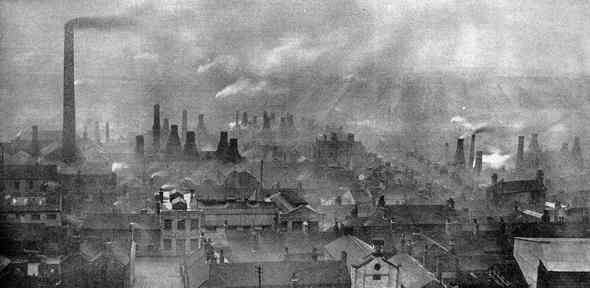A very brief history of capitalism and ecology: working notes from a textbook project

Public goods--such as clean air, healthy watersheds, or regenerative fisheries--can be sustained without difficulty so long as they are plentiful in relation to the population utilizing them. And many environmental public goods only became scarce in the last few centuries. This, we say, was due to the “Industrial Revolution.” But the technological modernization of production would not have happened without attendant changes in how people thought about property ownership, trade, and what sorts of obligations members of society owed one another.
In medieval Europe, property was owned only with social and political strings attached. The landholding nobility held their property in return for loyalty to the monarch, and by tradition these landlords and earls also had certain minimal obligations to the peasants who communally worked the land. The political ideas of John Locke and other classical liberal political theorists challenged these class-based hierarchical power structures in the name of liberty and equality. In the process, these philosophers laid the foundation for a much more individualistic society, in which ownership of property was more absolute, and obligations to others were negotiated largely by contracts. Agricultural land in many parts of England went from being communally used and managed to being privately owned. Peasants were driven off the land, and in place of their feudal landlords, many were forced to find employment in one of the factories emerging outside the larger cities. (E.P. Thompson, 2016) In this contract-based society, the price paid to former peasants for their labor, as well as the price consumers paid for food and goods, were increasingly set by the “laws” of supply and demand, rather than by traditional ideas of what the “just price” may be for a given good, or what mutual moral obligations the social classes owed each other. The life of a medieval peasant was often brutal, but this new system brought no immediate relief to the laboring class, as factory owners were ideologically freed from any moral obligations beyond paying contractually agreed wages.
Nevertheless, this new economic system, then called “capitalism” only by its critics, led to rapid gains in efficiency. Efficiency, in economic terms, refers to the value of the goods produced per unit of input. What is input? According to the classical economists Adam Smith and David Ricardo, any good or service that we buy requires some combination of three types of inputs: land, labor, and capital. (Adam Smith 1937) By “land” we mean any material resource, whether it be acres of cropland, crude oil, or iron ore. “Labor” means human labor. “Capital” includes machinery, tools, warehouses, or the money we invest in such things—essentially, anything besides raw materials and labor that you need to make something of value to people. Carpenters building a log house must put in a lot of labor, but no amount of labor is sufficient without raw materials (trees) and some kind of tools (saws, hammers, etc.). These tools are “capital,” or what Karl Marx called “the means of production.” Capitalism gave the owners of the key means of production (factory owners) great incentives to invent new tools and production techniques, which meant the same number of hired laborers can turn ever more raw materials into ever greater quantities of valued goods.
Capitalist economies as we know them are growth economies, and this fact has great implications for the environment. If the needs of 18th century consumers had remained static, the great increases in efficiency of production may have meant fewer natural resources would be used. But, predictably, consumer demand did not remain static. The needs and wants of a small but growing middle class proved to be effectively limited only by their ability to pay. Demand for goods grew exponentially, and capitalist production had no trouble keeping pace. At the turn of the 20th century, manufacturers in Europe and the USA began to worry, nonetheless, that people would eventually have all of their needs met, and supply would outstrip demand leading to what was then the relatively unknown possibility of a major economic recession. Luckily for these producers, though, the new science of marketing stepped in, promising to be able to stimulate unlimited needs in the mass of consumers for clothing, accessories, new inventions, and commodities of all types. Whether due to human nature or the magic of modern advertising, the feared satiation of consumers never came about. Furthermore, thanks to the global reach of European colonialism—and later the American-led, post-war, liberal international order—capitalism would, by the end of the twentieth century, spread to nearly every member of the present global community of nation-states. Today’s capitalist economies continue to grow at an average rate of over 3% (of gross domestic product or GDP) per year. (The Economist 2017, ??) In other words, the total dollar value of goods produced and sold on Earth is still exponentially increasing.
“Land,” or natural resources, as we noted above, is part of what is needed to feed this continuing global economic growth. And “the bowels and the surface of the earth” have indeed been “ransacked,” just as Hamilton predicted. Today, ores, fossil fuels, fertilizer components, and other non-renewable raw materials are mined wherever they exist in extractable concentrations. Net forest cover continues to decline globally due to logging. Industrial farming practices deplete topsoils, and oceans are fished at unsustainable rates. Even sand, unbelievably, has become a resource so scarce that illicit “sand mining” is a global problem. (UNEP-GEAS 2014) Moreover, just as the traditional moral obligations between the social classes in England were largely replaced by contractual legal relationships in the 17th and 18th centuries, the spread of capitalism globally has meant the established norms that regulated the use of plants, animals, land, and water in many traditional societies were also replaced by the Western model of individual property ownership oriented toward private monetary gain, with few substantial stewardship obligations standing in the way of production and “development.”
Capitalism has, at least for the first few centuries of its existence, brought tremendous gains in average economic prosperity, but along with progress in this domain have come enormous environmental challenges. Capitalist societies going into the twentieth century must answer a series of serious questions. Must our economies continue to grow? Economic growth incentivizes investment, and non-growing capitalist economies have always been considered “unhealthy.” But is continued exponential economic growth possible on a finite planet? Can the massive predicted disruptions in global climate due to increasing fossil energy use be averted?


Comments
Post a Comment